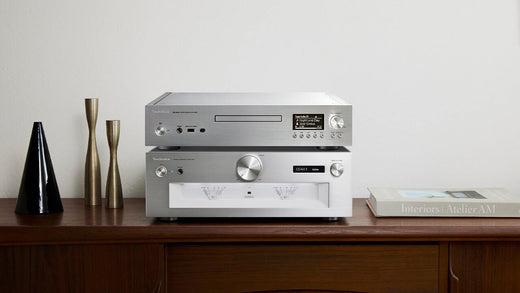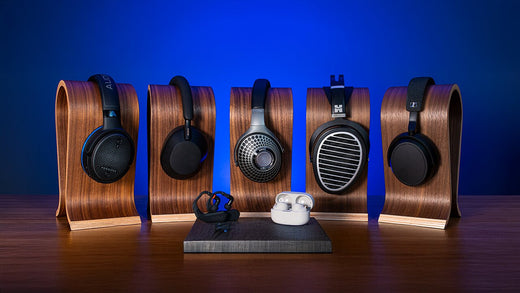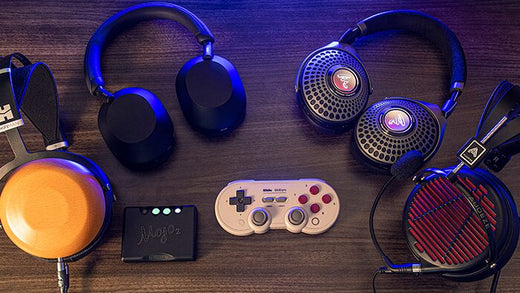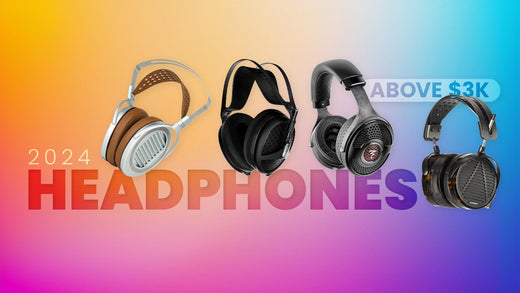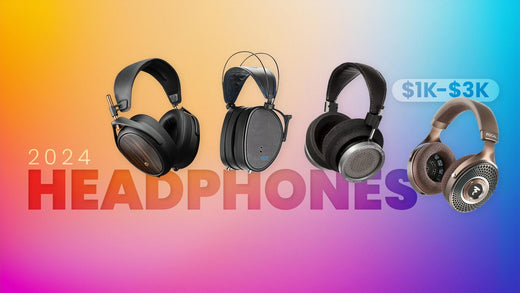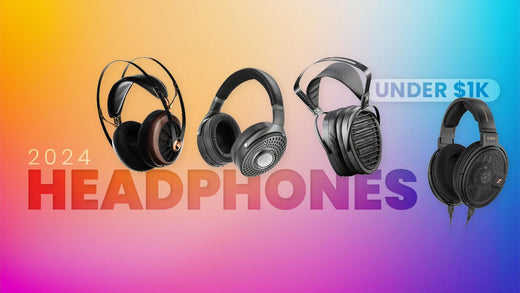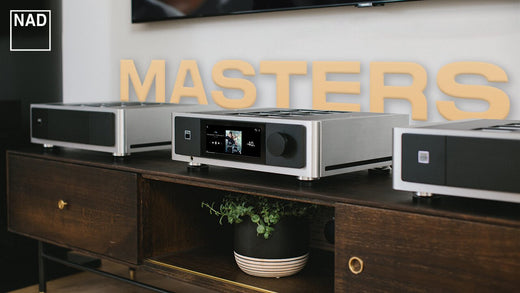Focal Utopia Headphone Review
Every few years a headphone comes along that reminds me why I love music. The Focal Utopia is one such headphone, and has quickly taken top position on a short list of my very favorite audiophile headphones.
My introduction to the Utopia was serendipitous. Moon Audio had just applied to become a dealer for Focal, but it turned out Focal was about to have its sights on Moon Audio.
Focal had recently paid a visit to HeadFi.org headquarters in Detroit. They wanted to let founder Jude Mansilla see and listen to their new high-end headphones. Focal asked Jude for advice on which dealers, aside from their normal speaker channels, they should target. Jude quickly recommended Moon Audio.
Jude is a good friend and a mensch, and one of the smartest audio minds in the world. He let us know that Sanjay, Focal’s North American Sales Director, wanted to visit Moon Audio's Cary, North Carolina office in a couple of days. Focal was taking a speedy trek across America explaining their new headphones to existing Focal speaker dealers and a handful of other companies. Little did I know how much of a treat was in store.
Jude Mansilla (left), founder of HeadFi.org, and Moon Audio Founder Drew Baird, PE.
Focal's New Reference Headphone
I really had no idea two new reference-quality headphones capable of recreating an “as recorded” listening experience were about to come through the door by way of a French speaker manufacturer. Sanjay arrived with a large suitcase. Opening his “sample case,” out popped two attractive but ominous-looking headphones - the Focal Elear, which cost $995, and the Utopia, which costs $4,400. (Note: Focal discontinued the Elear in 2019.)
I went straight for the Utopia. I plugged the Focal Utopia headphones into the Pass Labs HPA-1 headphone amplifier I’d warmed up for the meeting.
Listening to a single track, my ears began to smile.
Ever seen an ear smile? It happens with an amazing pair of headphones. In fact, the Utopia features the world's first full-range and fully open-back loudspeaker built within a pair of headphones, using pure beryllium formed in the brand-new "M" shape dome. More on that a little later.
Focal Utopia - $10,000 Headphones for Much Less
I use four songs to test new audio gear:
Patricia Barber: "Company"
Christina Aguilera: "You Lost Me"
Miles Davis: "So What"
Pink Floyd: "Paranoid Eyes"
These four songs are burly, full of dynamic range and other “testing gold.” I’ve listened to them often and with thousands of different audio gear setups. Any product weaknesses and sound quality flaws are easy to hear, pick out, and examine. But I didn’t hear any. Almost immediately, my jaw dropped as my ears melted. I have had numerous listening sessions with the Elear and Utopia headphones now. Feelings about these astonishing audiophile headphones today are no different than my initial listen out of Sanjay’s magic suitcase.
The Focal Utopia is at the top of my short list of favorites that now includes the Focal Stellia, Meze Empyrean, Fostex TH900 MKii, and RAAL SR1a. (Note: Drew's list of favorites updated May 2021). Stranded on an island with only one pair of cans, the Utopia would be my survival headphones, edging out Meze, Fostex, HiFiMan, Sennheiser, Sony, Audeze, and many other high-quality headphones. But the sound of the Utopias isn’t about something lacking in other great brands. No ...
Focal’s sound is more about how a French speaker maker has moved the bar.
Could Focal Utopia headphones cost $10,000? Yes, the sound is that good. Now let’s discuss why some very smart music lovers and audiophiles are buying the best-sounding headphones in the world for much less than they are worth.
I listen to a lot of Patricia Barber. I think of her as the Pink Floyd of jazz. Between her piano, percussionist, and bass player, there is a ton of stuff going on. Utopia's driver cuts through everything like a knife. I doubt even the best chefs' culinary skills could cut like this.
Musical layers appear naturally and are well-defined. Every note stands on its own with presence, resonance, guile, and charm. There is no clutter, hurry, or distortion. High frequencies are clean and smooth, never shrill or screechy. The midrange is slightly forward, while the bass is most defined by its texture and precision. On a headphone with distortion, and I don't mean to the point where the audio is edgy, the sound of many of Patricia Barber’s songs runs together. Nuances in her music are lost. Listen to "Mourning Grace" to understand the importance of nuance, silence, and clarity in music and audio gear.
Stranded on a desert island with only one pair of cans, the Utopia would be my survival headphones.
Focal Utopia Driver: Pure Beryllium M-Shaped Dome
Focal Utopia and Elear headphones represent the next revolution in driver design, similar to the Sennheiser HD800 headphones when they first arrived. The diameter of Focal’s driver closely follows the diameter of the voice coil with an open back magnet assembly, thus there is no trapped air behind the dome.
The driver uses pure beryllium formed in the new "M" shaped dome, which is extremely rigid and super light, resulting in incredibly low distortion and quite possibly the best in the headphone marketplace. I was a very passionate DIY speaker builder in my early years In fact, I went to Penn State to become an acoustical engineer. I ended up swtiching to structural engineering, but that is another story.
Anyway, I had played around with all types of tweeters: soft domes with various materials like textile, fabric, silk; and metal domes such as aluminum and titanium. I remember when Focal came out with the first inverted dome beryllium tweeter in the 1990s. It was the hottest news at the time and I could not wait to get it. It offered a much more rigid structure but was super lightweight. Fabric tweeters were smooth but colored. Metal dome tweeters were detailed and fast but often had a glaring beam or ringing to them -- especially titanium drivers. Beryllium offered outstanding off-axis dispersion and a silky-smooth sound while still managing to provide extreme detail. It was almost a perfect balance. The original beryllium drivers were a little too soft but as iterations continued to improve I was always impressed with them. Later, ribbon tweeters like the RAAL would steal my heart. But Beryllium always had a special place in my heart. This is why I gravitate so much to the Utopia sound.
Focal Utopia Sound Quality
When you first put on a pair of Focal Utopia headphones, you feel energy behind the sound. Holding the headphones in your hand while music plays feels like you’re holding a speaker, not a headphone.
I haven’t experienced this effect from any other headphone. Think of Focal Utopia headphones as miniature ported speakers with the most amazing sound you can put on your head. Utopia’s sound reminds me of the old AKG K1000 Earspeakers.
AKG K1000
The AKG K1000 had pads external to the driver plate. Listeners would rotate the driver plate to produce the right presentation between drivers and ears, creating a unique design and listening experience. The Utopia’s sound and experience are just as unique; it's not like any other high-end headphone I’ve heard.
The shape of the driver I assume is what is creating the energy field my ears are feeling. It is a unique shape designed to push more of the sound out on the forward side of the driver vs the rear. It's interesting to me that if you place your ear on the backside of the driver or outside the cup, how flat and dead the sound is. This is the total opposite of a planar driver headphone.
If you put an earcup on each side of a driver, the sound would be identical. I feel like I am getting twice the energy with the Focal drivers, which translates to remarkable tonal balance. Bottom line is I just love this headphone for so many reasons.
Dragon Cables for Focal Utopia
Recommended Cable: Black Dragon Premium
On the topic of providing these phones with all the tools needed to be their best, here are some upgrade cable recommendations. In most cases, I prefer a copper cable to a silver cable for the Utopia. I find copper falls more in line with what the beryllium driver needs. The beryllium driver already provides tons of detail, articulation and control. The Utopia's stock cable is 15 feet long, very heavy and unyielding. It is my only complaint about the Utopia. The cable is too heavy on the head and I have to coil it in my lap so it's not bothersome. The new Utopia with Premium Accessories has now changed the cable type, but still the Dragon is the best choice to squeeze out every last drop of performance.
The Black Dragon Premium Cable is what I prefer with the Utopia and what I used for this review. This cable uses 4 x 21.5AWG Teflon-insulated stranded conductors using pure single crystallized UP-OCC pure copper with 7N purity 99.99998%. It offers the same quality construction as our standard Black Dragon cable, with enhancements like premium rhodium-plated Furutech connectors and Mundorf MSolder SUPREME Silver-Gold that lend an extra layer of clarity to your music.
The Black Dragon provides a fuller presentation with a meatier sound and improved clarity over the Utopia's stock cable. It adds a little warmth, but not too much. I don't find our copper cables to be overly warm the way Cardas cables are. I reference this as we sell Cardas Cables as a complement to our Dragon line, as there are indeed times when extra warmth is required.
The Black Dragon tends to be on the natural to neutral front with more warmth and a fuller presentation over the Blue Dragon. It retains the headphones ability to deliver a ton of detail but by providing a little smoother detailed response. This is not a rolled off characteristic, as there is no loss in resolution it just takes the sharp edges off in the right places. If you want an even warmer, smoother presentation look at the Cardas Clear headphone cable. If your system is overly dark then by all means try our Silver Dragon Premium Cable. There really is no right or wrong here.
For the Focal Elear, I prefer the Silver Dragon Premium Cable more often than our Black Dragon. The Silver Dragon opens up the top-end frequencies and adds more layers of resolution to the Elear sound signature, which helps move it closer to the Utopia in terms of dynamics and detail.
Because of the smooth nature of the Focal Utopia, I often prefer listening with a tube amp. I primarily use the Dragon Inspire IHA-1 tube headphone amp, both designed by the legendary Dennis Had, the founder of Cary audio who is now in semi-retirement. The Dragon Inspire IHA-1 was very well received by Nicolas Debard, the Focal Utopia Product Manager at CanJam London. He thought it was the perfect match for the Utopias. This is not to say the Utopia is not a good match for solid state amps, but for my favorite music (jazz, blues, Americana), I choose a tube amp . I also love the Auris Audio Nirvana with the Utopia. This is a powerhouse beat of an amp and the power is unmatched.
For a solid state amp, I found the Pass Labs HPA-1 to be my favorite with the Utopia. This amp has such amazing command and control. On big orchestral pieces, the presentation and soundstage are enormous. Listen to Hans Zimmer's score for the Dark Knight as well such things as Les Claypool on the bass. Wow, just wow. The frontman for Primus would love this headphone. This is a headphone that makes the cost of higher-res downloads worth every penny.
I've spent more money on music in the last few months than I did during the last year so I could thoroughly enjoy every bit of my Utopias. Yes, the price tag of the Utopia can be out of reach for many, but hopefully, you can find a way to save up or sell some gear to get a pair.
Works of Art, Made in France
You are easily getting double what you are paying with both headphones. I am enamored that the Elear is only $995. I can't think of another headphone at $995 that comes close to the build quality and thought behind the design of this headphone. I'm hard-pressed to find a $2,000 headphone that can compete with the Elear build quality.
The Utopia has the same Elear build quality with military specs and exotic materials like a 100% carbon fiber frame, Pittards lambskin leather headband and memory foam earpads, and a pure beryllium M-shaped dome. These are just a few examples of why you receive a $10,000 value with the Utopia headphones for a $4,400 price tag.
Focal’s Utopia innovations in design and build quality defeat distortion’s, bear making these precious headphones the best in the world. Music sounds natural and present, and there’s no bear between you and the people who created your favorite music, no bear between Patricia Barber and me.
A growing tribe of music lovers is buying our supply of Utopias almost as fast as the team in France can craft them. If you love music, want the best headphones, and want to save money since you will purchase cans worth more than twice their current cost, treat yourself to a pair of Utopias. And join me on an island of beautiful music, amazing sound, and where everyone speaks French and we do, too.
Focal Utopia Specifications
Technical Features
Loudspeaker: 137⁄64“ (40mm) pure Beryllium “M” shape dome
Frequency Range: 5Hz - 50kHz
Impedance: 80 Ohms
Sensitivity: 104dB SPL / 1mW @ 1kHz
THD: <0,2% @ 1kHz / 100dB SPL
PHysical features
Type: Circum-aural open back headphones
Weight: 1.08lb (490g)
Cable length: 13.1ft (4m)
Connectors: 1 x Jack 01/4" (6.35mm) stereo; 2 x 03⁄8" (9.5mm) Lemo®
- Carrying case: 12.8" x 10.2" x 6.5" (326mm x 260mm x 164mm)





